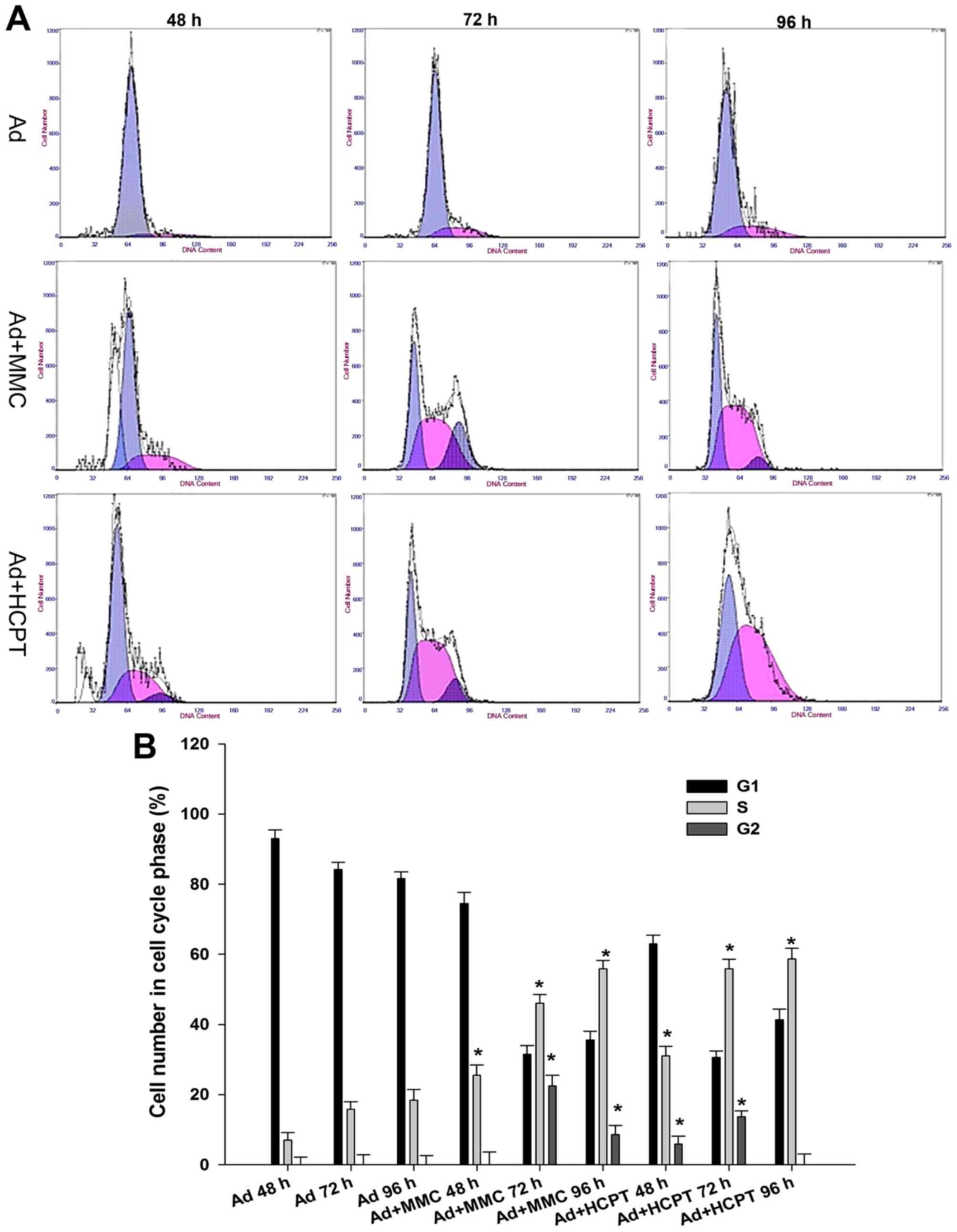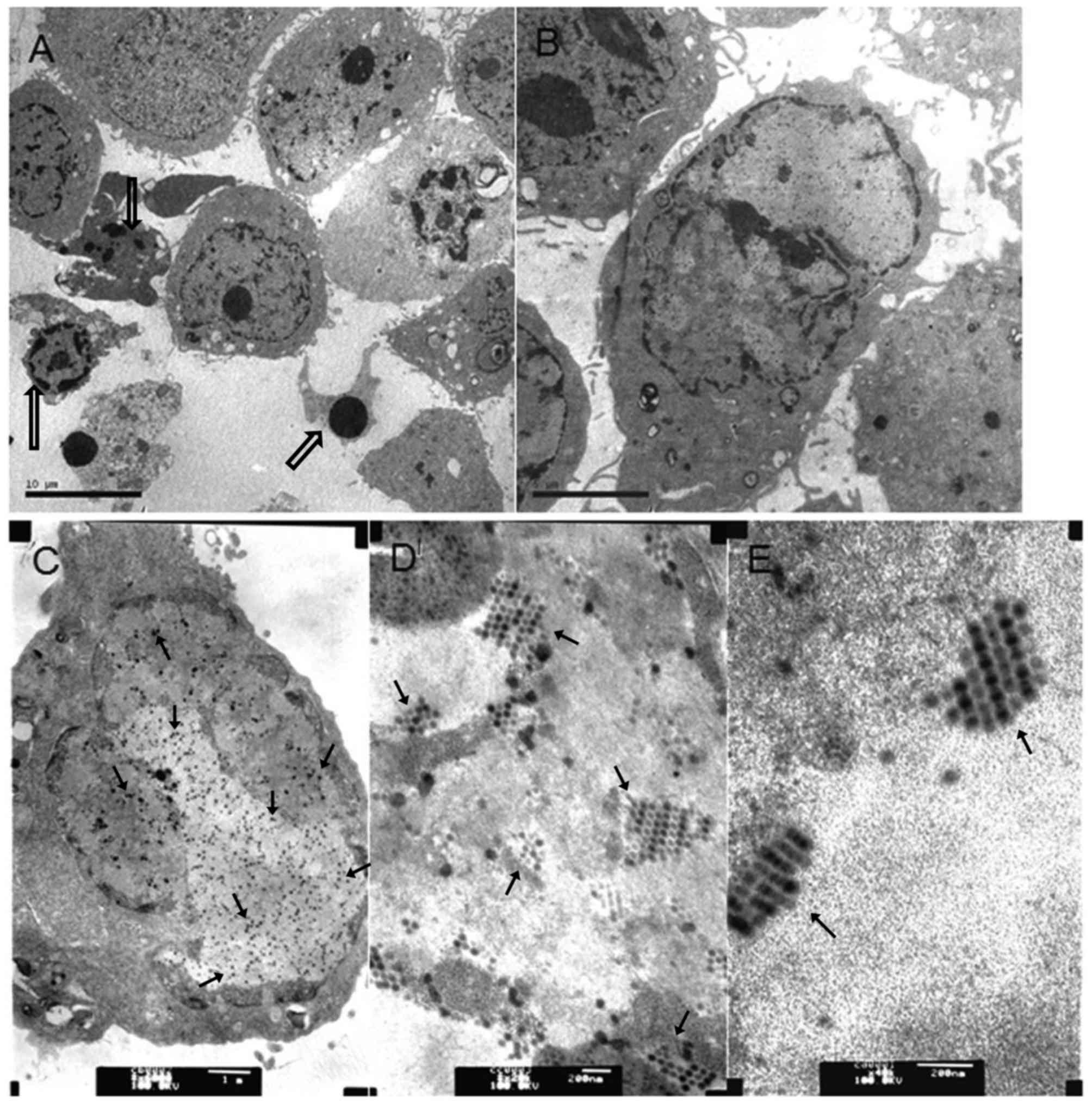|
1
|
Cheung G, Sahai A, Billia M, Dasgupta P
and Khan MS: Recent advances in the diagnosis and treatment of
bladder cancer. BMC Med. 11:132013. View Article : Google Scholar : PubMed/NCBI
|
|
2
|
Sylvester RJ, van der Meijden AP,
Oosterlinck W, Witjes JA, Bouffioux C, Denis L, Newling DW and
Kurth K: Predicting recurrence and progression in individual
patients with stage Ta T1 bladder cancer using EORTC risk tables: A
combined analysis of 2596 patients from seven EORTC trials. Eur
Urol. 49:466–477. 2006. View Article : Google Scholar : PubMed/NCBI
|
|
3
|
Voutsinas GE and Stravopodis DJ: Molecular
targeting and gene delivery in bladder cancer therapy. J Buon. 14
Suppl 1:69–78. 2009.
|
|
4
|
Babjuk M, Oosterlinck W, Sylvester R,
Kaasinen E, Böhle A and Palou-Redorta J; European Association of
Urology (EAU), : EAU guidelines on non-muscle-invasive urothelial
carcinoma of the bladder. Eur Urol. 54:303–314. 2008. View Article : Google Scholar : PubMed/NCBI
|
|
5
|
Crooke ST and Bradner WT: Mitomycin C: A
review. Cancer Treat Rev. 3:121–139. 1976. View Article : Google Scholar : PubMed/NCBI
|
|
6
|
Verweij J and Pinedo HM: Mitomycin C:
Mechanism of action, usefulness and limitations. Anticancer Drugs.
1:5–13. 1990. View Article : Google Scholar : PubMed/NCBI
|
|
7
|
Wu Y, Zeng FQ, Wang YB and Wang L:
Hydroxycamptothecin promotes the apoptosis of prostate cancer cell
line PC-3. Zhonghua Nan KeXue. 13:890–894. 2007.(In Chinese).
|
|
8
|
Fan J, Tang X and Zhang X:
10-Hydroxycamptothecin induces apoptosis in human T24 urinary
bladder cancer cells. Zhonghua Yi XueZaZhi. 78:301–304. 1998.(In
Chinese).
|
|
9
|
Liu LF, Desai SD, Li TK, Mao Y, Sun M and
Sim SP: Mechanism of action of camptothecin. Ann N Y Acad Sci.
922:1–10. 2000. View Article : Google Scholar : PubMed/NCBI
|
|
10
|
Dean M, Fojo T and Bates S: Tumour stem
cells and drug resistance. Nat Rev Cancer. 5:275–284. 2005.
View Article : Google Scholar : PubMed/NCBI
|
|
11
|
Bochner BH: Gene therapy in bladder
cancer. Curr Opin Urol. 18:519–23. 2008. View Article : Google Scholar : PubMed/NCBI
|
|
12
|
Wada Y, Gotoh A, Shirakawa T, Hamada K and
Kamidono S: Gene therapy for bladder cancer using adenoviral
vector. Mol Urol. 5:47–52. 2001. View Article : Google Scholar : PubMed/NCBI
|
|
13
|
Chester JD, Kennedy W, Hall GD, Selby PJ
and Knowles MA: Adenovirus-mediated gene therapy for bladder
cancer: Efficient gene delivery to normal and malignant human
urothelial cells in vitro and ex vivo. Gene Ther. 10:172–179. 2003.
View Article : Google Scholar : PubMed/NCBI
|
|
14
|
Wang F, Wang Z, Tian H, Qi M, Zhai Z, Li
S, Li R, Zhang H, Wang W, Fu S, et al: Biodistribution and safety
assessment of bladder cancer specific recombinant oncolytic
adenovirus in subcutaneous xenografts tumor model in nude mice.
Curr Gene Ther. 12:67–76. 2012. View Article : Google Scholar : PubMed/NCBI
|
|
15
|
Wang D, Wang Z, Tian J, He X, Chowdhury
WH, Zhang X, Li S and Rodriguez R: Prostate stem cell antigen
enhancer and uroplakin II promoter based bladder cancer targeted
tissue-specific vector. Urol Oncol. 28:164–169. 2010. View Article : Google Scholar : PubMed/NCBI
|
|
16
|
Zhai Z, Wang Z, Fu S, Lu J, Wang F, Li R,
Zhang H, Li S, Hou Z, Wang H and Rodriguez R: Antitumor effects of
bladder cancer-specific adenovirus carrying E1A-andro gen receptor
in bladder. cancer. 19:1065–1074. 2012.
|
|
17
|
Guo W, Zhu H, Zhang L, Davis J, Teraishi
F, Roth JA, Stephens C, Fueyo J, Jiang H, Conrad C and Fang B:
Combination effect of oncolytic adenovirotherapy and TRAIL gene
therapy in syngeneic murine breast cancer models. Cancer GeneTher.
13:82–90. 2006.
|
|
18
|
Alonso MM, Gomez-Manzano C, Jiang H,
Bekele NB, Piao Y, Yung WK, Alemany R and Fueyo J: Combination of
the oncolytic adenovirus ICOVIR-5 with chemotherapy provides
enhanced anti-glioma effect in vivo. Cancer Gene Ther. 14:756–761.
2007. View Article : Google Scholar : PubMed/NCBI
|
|
19
|
Zhou JR, Yu L, Mai Z and Blackburn GL:
Combined inhibition of estrogen-dependent human breast carcinoma by
soy and tea bioactive components in mice. Int J Cancer. 108:8–14.
2004. View Article : Google Scholar : PubMed/NCBI
|
|
20
|
Sánchez-Prieto R, Quintanilla M, Cano A,
Leonart ML, Martin P, Anaya A and Ramón y Cajal S: Carcinoma cell
lines become sensitive to DNA-damaging agents by the expression of
the adenovirus E1A gene. Oncogene. 13:1083–1092. 1996.PubMed/NCBI
|
|
21
|
Ganjavi H, Gee M, Narendran A, Parkinson
N, Krishnamoorthy M, Freedman MH and Malkin D: Adenovirus-mediated
p53 gene therapy in osteosarcoma cell lines: Sensitization to
cisplatin and doxorubicin. Cancer Gene Ther. 13:415–419. 2006.
View Article : Google Scholar : PubMed/NCBI
|
|
22
|
Brader KR, Wolf JK, Hung MC, Yu D,
Crispens MA, van Golen KL and Price JE: Adenovirus E1A expression
enhances the sensitivity of an ovarian cancer cell line to multiple
cytotoxic agents through an apoptotic mechanism. Clin Cancer Res.
3:2017–2024. 1997.PubMed/NCBI
|
|
23
|
Ueno NT, Bartholomeusz C, Herrmann JL,
Estrov Z, Shao R, Andreeff M, Price J, Paul RW, Anklesaria P, Yu D,
Hung MC, et al: E1A-mediated paclitaxel sensitization in
HER-2/neu-overexpressing ovarian cancer SKOV3.ip1 through apoptosis
involving the caspase-3 pathway. Clin Cancer Res. 6:250–259.
2000.PubMed/NCBI
|
|
24
|
Liao Y and Hung MC: Regulation of the
activity of p38 mitogen-activated protein kinase by Akt in cancer
and adenoviral protein E1A-mediated sensitization to apoptosis. Mol
Cell Biol. 23:6836–6848. 2003. View Article : Google Scholar : PubMed/NCBI
|
|
25
|
Liao Y and Hung MC: A new role of protein
phosphatase 2a in adenoviral E1A protein-mediated sensitization to
anticancer drug-induced apoptosis in human breast cancer cells.
Cancer Res. 64:5938–5942. 2004. View Article : Google Scholar : PubMed/NCBI
|
|
26
|
de Stanchina E, McCurrach ME, Zindy F,
Shieh SY, Ferbeyre G, Samuelson AV, Prives C, Roussel MF, Sherr CJ
and Lowe SW: E1A signaling to p53 involves the p19(ARF) tumor
suppressor. Genes Dev. 12:2434–2442. 1998. View Article : Google Scholar : PubMed/NCBI
|
|
27
|
Duelli DM and Lazebnik YA: Primary cells
suppress oncogene-dependent apoptosis. Nat Cell Biol. 2:859–862.
2000. View
Article : Google Scholar : PubMed/NCBI
|
|
28
|
McCurrach ME, Connor TM, Knudson CM,
Korsmeyer SJ and Lowe SW: bax-deficiency promotes drug resistance
and oncogenic transformation by attenuating p53-dependent
apoptosis. Proc Natl Acad Sci USA. 94:pp. 2345–2349. 1997;
View Article : Google Scholar : PubMed/NCBI
|
|
29
|
Su JL, Cheng X, Yamaguchi H, Chang YW, Hou
CF, Lee DF, Ko HW, Hua KT, Wang YN, Hsiao M, et al: FOXO3a
dependent mechanism of E1A-Induced chemosensitization. Cancer Res.
71:6878–6887. 2011. View Article : Google Scholar : PubMed/NCBI
|
|
30
|
Olivier M and Theillet C: Mitomycin C
induced apoptosis: influence of cell cycle phase. Biology of the
Cell. 88:82–82a. 1996. View Article : Google Scholar
|
|
31
|
Hu W, Zhang C, Fang Y and Lou C:
Anticancer properties of 10-hydroxycamptothecin in a murine
melanoma pulmonary metastasis model in vitro and in vivo. Toxicol
In Vitro. 25:513–520. 2011. View Article : Google Scholar : PubMed/NCBI
|
|
32
|
Tanaka M and Grossman HB: Connexin 26 gene
therapy of human bladder cancer: Induction of growth suppression,
apoptosis, and synergy with Cisplatin. Hum Gene Ther. 12:2225–2236.
2001. View Article : Google Scholar : PubMed/NCBI
|
|
33
|
Li Y, Yu DC, Chen Y, Amin P, Zhang H,
Nguyen N and Henderson DR: A hepatocellular carcinoma-specific
adenovirus variant, CV890, eliminates distant human liver tumors in
combination with doxorubicin. Cancer Res. 61:6428–6436.
2001.PubMed/NCBI
|














